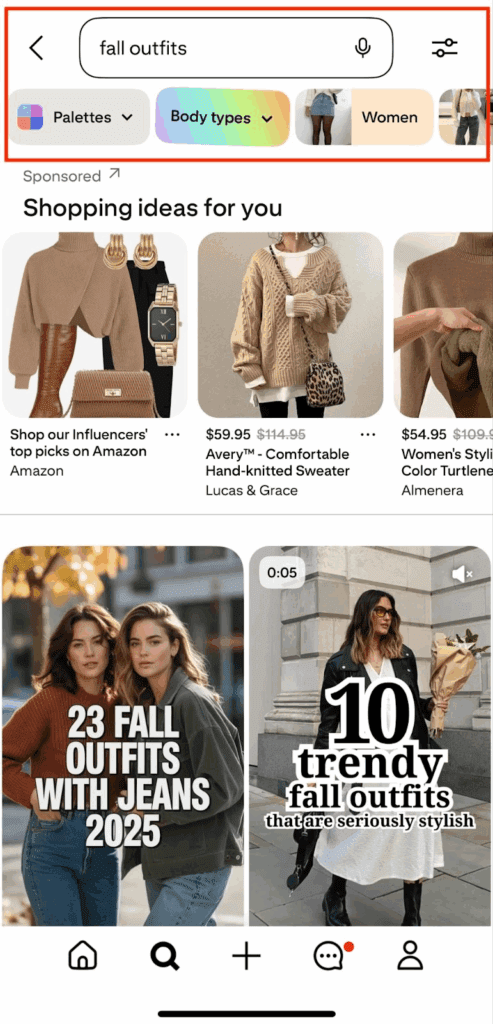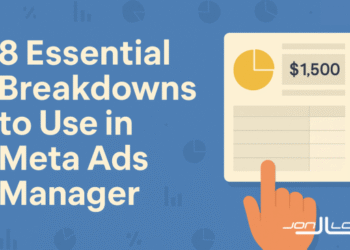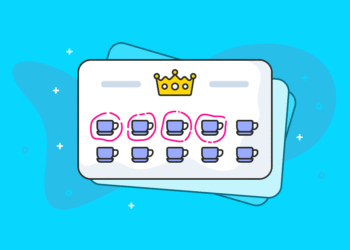
In this guide, you’ll learn exactly how the Pinterest search algorithm operates, the different types of search available on the platform, and actionable tips to optimize your content for better search results. Whether you’re new to Pinterest marketing or looking to refresh your strategy, these insights will help you get found by the right people at the right time.
How Pinterest Search Works
Pinterest operates fundamentally differently from traditional social media platforms. While Instagram or Facebook content typically gets engagement for just a few hours to maybe a couple of days, Pinterest works more like Google Search. Over 60% of saves were from Pins over a year old, with top Pins continuing to drive traffic and engagement for a very long time.
Think of Pinterest as a visual search engine where people come to discover ideas, plan purchases, and find inspiration. When someone searches on Pinterest, the platform’s algorithm considers several key factors:
Relevance: How well your Pin matches what someone is searching for, based on your keywords, Pin description, and the content of your linked page.
Quality: Pinterest measures engagement signals like saves, clicks, and comments to determine which Pins deserve broader distribution.
Engagement: Pins that generate more engagement are rewarded with more impressions. The top 1% most viral Pins account for over 50% of total impressions and clicks alone.
Freshness: While older Pins can continue performing well, Pinterest also values fresh content. Half of the Pins driving engagement to profiles in the study were created within the last year.
The Pinterest search algorithm is designed to surface the most relevant, high-quality content that will resonate with each individual user’s interests and search intent.
Types of Pinterest Search
Understanding the different ways people can search on Pinterest will help you optimize your content for maximum discoverability.
Text-Based Search
This is the most common way people search on Pinterest – simply typing keywords into the search bar. When someone searches for “fall home décor ideas” or “healthy meal prep recipes,” Pinterest scans Pin titles, descriptions, alt text, and board names to find the most relevant results.
Text-based search is where your keyword optimization efforts will have the biggest impact. Pinterest needs to understand what your Pin is about to show it to the right people.

Visual Search
Pinterest’s Lens tool allows users to search by uploading an image or clicking on objects within existing Pins. This feature is particularly powerful for product discovery and shopping. When someone sees a piece of furniture they like in a Pin, they can click on it to find similar items or related inspiration.

Visual search is especially important for businesses in fashion, home décor, food, and other visually-driven categories. Making sure your product images are clear and well-lit helps Pinterest’s visual search technology identify and categorize them correctly.
Guided Search
After someone performs an initial search, Pinterest often suggests additional filters and refinements to help narrow down results. For example, searching “recipes” might show guided search options like “Easy,” “Healthy,” “Dinner,” or “Vegetarian.”
This guided search feature helps Pinterest users find exactly what they’re looking for while giving you opportunities to target more specific, long-tail keywords in your content.

Tips for Better Results in Pinterest Search
Now that you understand how Pinterest search works, let’s dive into specific strategies to improve your search visibility and rankings.
Optimize Your Profile
Your Pinterest profile is your foundation for search success. Include relevant keywords naturally in your display name and bio to help Pinterest understand what type of content you create.
Make sure your profile is set up as a business account to access Pinterest Analytics and other professional features that will help you track your search performance.
Use Keyword-Rich Board Titles & Descriptions
Your board titles and descriptions are crucial signals that help Pinterest categorize your content. Instead of cute or clever board names that don’t clearly describe the content, use descriptive, keyword-rich titles.
Replace vague names like “Yummy Stuff” with specific titles like “Healthy Breakfast Recipes” or “Quick Weeknight Dinners.” Include relevant keywords in your board descriptions as well, but keep them natural and helpful for users.
Well-optimized boards not only help with search rankings but also make it easier for Pinterest users to decide whether to follow your boards or save your Pins.

Write Pin Titles & Descriptions with SEO in Mind
Your Pin titles and descriptions are prime real estate for Pinterest SEO. Pin titles are still partially visible in users’ feeds — at least the first 35-45 characters, so make those opening words count.
In your Pin titles, lead with your most important keyword and include compelling language that encourages clicks. For example: “Quick Healthy Lunchbox Ideas for Kids (Ready in 15 Minutes!)”
For descriptions, focus on accuracy and relevance rather than length. The most viral Pins tended to have shorter descriptions, averaging in the range of 220-232 characters. Keep each Pin highly focused on the most relevant terms rather than trying to cover multiple topics in one description.
Leverage Alt Text & File Names
Alt text serves double duty on Pinterest – it makes your content accessible to users with visual impairments while also providing another opportunity to include relevant keywords for search optimization.
Recent data shows significant benefits to including alt text: Pins with alt text are earning 25% more impressions, 123% more outbound clicks, and 56% more profile visits on average.
Write descriptive, accurate alt text that explains what’s in your image while naturally incorporating your target keywords. For example: “Colorful Buddha bowl with quinoa, roasted vegetables, and tahini dressing on white marble countertop.”
Publish Fresh Pins Consistently
While older Pins can continue performing well, Pinterest values fresh content in its search rankings. Pinterest recommends that creators try to publish as much as 5-25 new Fresh Pins per day, as success is in part a numbers game.
The key is creating “Fresh Pins” – brand new Pins that link to your content – rather than just saving existing Pins to new boards. Over 90% of traffic to creator and brand websites were from Creates (Fresh Pins) rather than saves of existing content.
This is where tools like Tailwind SmartPin can be incredibly valuable. Tailwind SmartPin creates and schedules Fresh Pins for your blog posts, products, or pages every single week.
Instead of manually designing and posting Pins, SmartPin handles the content creation for you. You just review the ready-to-go Pins, approve the ones you like, and Tailwind handles the rest – from posting at optimal times to tracking performance.
Common Mistakes to Avoid
Even well-intentioned Pinterest marketers can hurt their search performance with these common mistakes:
- Keyword Stuffing: Including too many unrelated keywords in your Pin descriptions confuses Pinterest’s algorithm and can actually hurt your rankings. Since Pinterest distributes content primarily based on topical relevance, sending mixed signals about what a Pin is about could lead to your content being ranked lower on each individual term.
- Using Vague Board Names: Board titles like “Things I Love” or “Random Inspiration” don’t help Pinterest understand your content or show it to interested users. Be specific and descriptive instead.
- Ignoring Seasonal Trends: Pinterest users often search for seasonal content weeks or months in advance. Plan your content calendar accordingly and publish holiday or seasonal content early to catch the search wave.
- Turning Off Shopping Recommendations: This might seem counterintuitive, but Pins with shopping recommendations enabled actually perform better. Pins with shoppable recommendations enabled perform better than those that do not, earning far more clicks which are engagement signals rewarded by Pinterest with more distribution.
- Inconsistent Posting: Sporadic posting makes it harder to build momentum and authority in Pinterest search. Develop a consistent publishing schedule to maintain visibility.
How to Track Your Pinterest SEO Success
Pinterest Analytics provides valuable insights into how your content is performing in search results. Focus on these key metrics:
- Impressions: How many times your Pins were shown to users, including in search results. Growing impressions indicate better search visibility.
- Saves: The number of times users saved your Pins to their boards. This is a strong engagement signal that can boost your search rankings.
- Outbound Clicks: Clicks from your Pins to your website. This metric directly measures how well your Pinterest search optimization is driving traffic to your business.
- Top Pins: Identify which of your Pins are getting the most impressions and saves. Analyze what makes them successful and apply those insights to future content.
Use this data to refine your keyword strategy, identify your best-performing content types, and adjust your posting schedule. If certain boards or Pin types aren’t performing well in search, consider optimizing their titles, descriptions, and keywords.
Pinterest Search vs. Other Platforms
Understanding Pinterest’s unique search behavior helps set realistic expectations and inform your strategy. Unlike Google, where users often search with immediate purchase intent, Pinterest users are typically in discovery and planning phases.
Pinterest searches tend to be more inspiration-focused: “living room décor ideas,” “healthy dinner recipes,” or “summer outfit inspiration.” This means your content should focus on providing ideas, solutions, and inspiration rather than hard sales pitches.

The visual nature of Pinterest search also means your Pin design is crucial for performance. 89% of the most viral Pins were Image Pins, and vertical images with a 2:3 aspect ratio perform best.
Advanced Pinterest Search Optimization
Once you’ve mastered the basics, consider these advanced strategies:
Seasonal Content Planning: Pinterest users search for seasonal content months in advance. Start creating and publishing Halloween content in August, Christmas content in September, and summer content in early spring.
Long-tail Keyword Targeting: While broad keywords are competitive, long-tail keywords often have less competition and more specific search intent. Target phrases like “easy gluten-free dinner recipes for families” instead of just “dinner recipes.”
Cross-Board Optimization: Save your best-performing Pins to multiple relevant boards to increase their chances of appearing in different searches. Just make sure the boards are genuinely relevant to avoid appearing spammy.
Trend Monitoring: Use Pinterest Trends and the search bar’s autocomplete suggestions to identify rising topics and keywords in your niche. Create content around trending topics before they become oversaturated.
FAQ
How long does it take for new Pins to appear in Pinterest search results?
Fresh Pins typically start appearing in search results within a few hours to a few days of publishing. However, it can take several weeks for Pinterest’s algorithm to fully understand and optimize the distribution of your content. Pins may technically live forever, but when it comes to which Pins Pinterest actually shows to users in feeds and search results, even the most viral Pins will eventually peak and then start fading off.
Should I use hashtags in my Pin descriptions for better search results?
Hashtags can be helpful but aren’t required. 19% of the most viral Pins included one or more hashtags, and Pinterest likely interprets hashtags as search keywords to help classify content. If you do use hashtags, treat them like keywords and keep them relevant to your content.
How many keywords should I include in each Pin description?
Focus on quality over quantity. Most Pin descriptions used five or fewer keywords, and when using multiple keywords on a Pin, keep them tightly coupled so that someone searching for one term is likely to also be interested in content about the other terms.
Do scheduled Pins perform worse in search than Pins published directly on Pinterest?
No, scheduled Pins don’t perform worse. In fact, Pins driving high volumes of traffic were up to 54% more likely to be published through Tailwind than to be published directly on Pinterest. This is likely because scheduling tools guide users toward best practices.
Can Tailwind help improve my Pinterest search performance?
Yes. Tailwind makes it easier to consistently publish Creates (new Pins) — which drive over 90% of traffic from Pinterest. With SmartPin, Tailwind automatically generates and schedules fresh, optimized Pins for your blog posts, products, or pages each week. This ensures you’re consistently publishing keyword-rich, high-quality Pins — the exact type of content Pinterest prioritizes in search. Tailwind also guides you to best practices such as the recommended posting frequency (5–25 Pins per day) and optimal Pin design, which improves both visibility and engagement.
How important is Pin design for search performance?
Pin design is crucial for search success. 89% of the most viral Pins were Image Pins, and vertical images perform significantly better than horizontal or square images. The visual appeal of your Pin directly impacts click-through rates, which are important engagement signals for Pinterest’s search algorithm.
Can old Pins still rank well in Pinterest search?
Absolutely! This is one of Pinterest’s greatest strengths. In the past 90 days, over 60% of saves on Pins linking to users’ websites were on Pins over a year old, and over 40% were on Pins over two years old. Well-optimized Pins can continue driving traffic for years.
Should I optimize my content for Pinterest’s visual search feature?
Yes, especially if you’re in visual categories like fashion, home décor, or food. Ensure your product images are clear, well-lit, and show items distinctly. Pinterest’s visual search technology works best when it can easily identify objects in your images.
How often should I publish new Pins for optimal search performance?
Consistency matters more than frequency, but Pinterest does reward active accounts. Pinterest recommends that creators try to publish as much as 5-25 new Fresh Pins per day. However, quality should never be sacrificed for quantity. Focus on creating valuable, well-optimized content on a schedule you can maintain.

The post Pinterest Search: How It Works + Tips for Better Results appeared first on Tailwind Blog.













